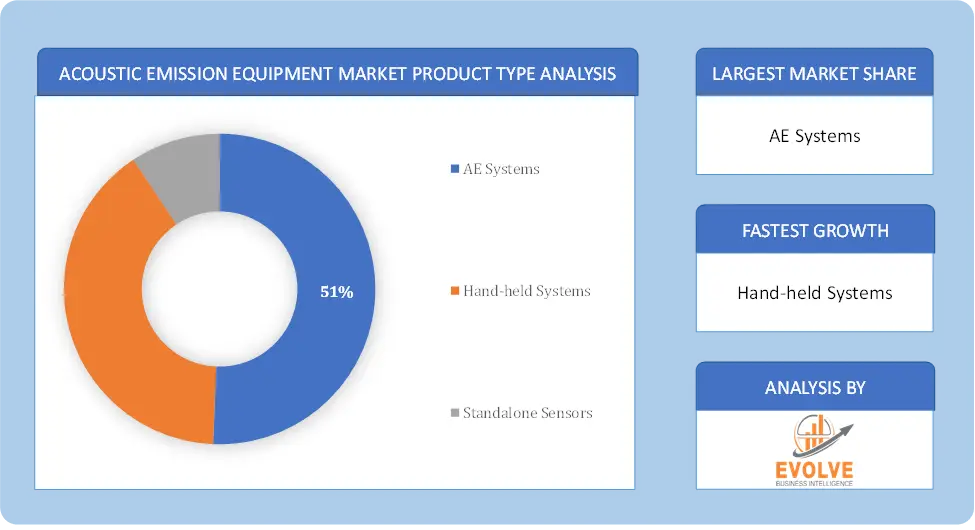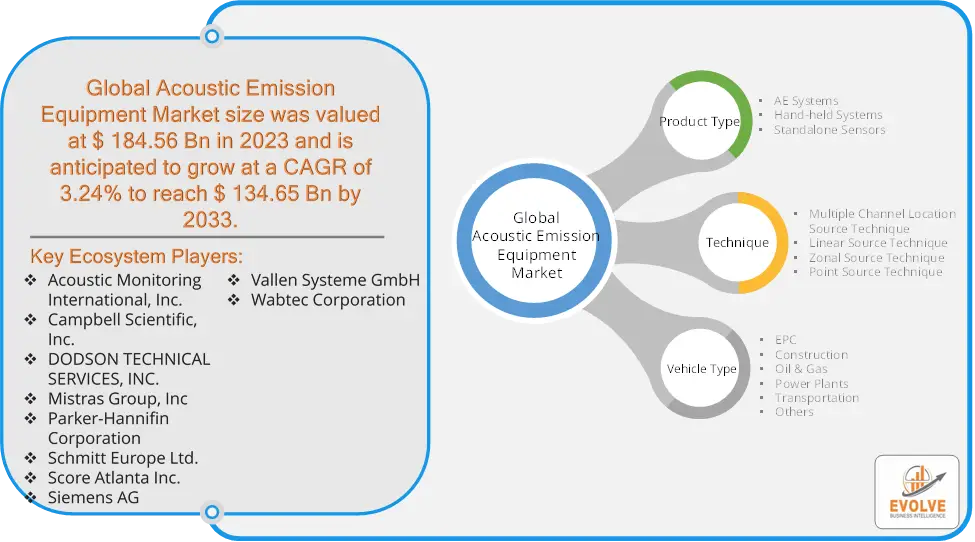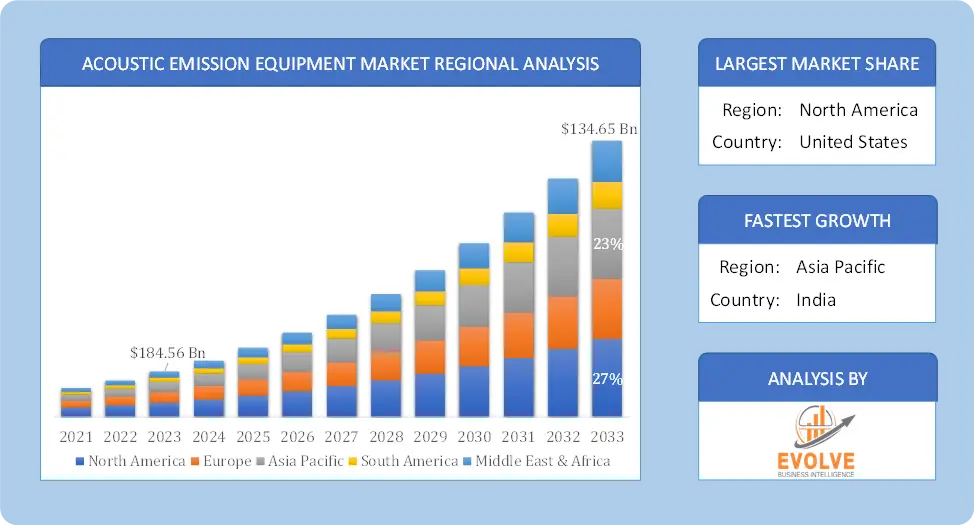Acoustic Emission Equipment Market Analysis and Global Forecast 2023-2033
$ 1,390.00 – $ 5,520.00Price range: $ 1,390.00 through $ 5,520.00
Acoustic Emission Equipment Market Research Report: By Product Type (AE Systems, Hand-held Systems, Standalone Sensors,), By Technique (Multiple Channel Location Source Technique, Linear Source Technique, Zonal Source Technique, Point Source Technique,), By Vehicle Type (EPC, Construction, Oil & Gas, Power Plants, Transportation, Others,), and by Region — Forecast till 2033
Page: 148
Acoustic Emission Equipment Market Overview
The Acoustic Emission Equipment Market Size is expected to reach USD 134.65 Billion by 2033. The Acoustic Emission Equipment industry size accounted for USD 184.56 Billion in 2023 and is expected to expand at a compound annual growth rate (CAGR) of 3.24% from 2023 to 2033. The Acoustic Emission Equipment Market involves the production and distribution of devices that detect high-frequency stress waves emitted by materials under stress or deformation. These tools are crucial in non-destructive testing (NDT) and structural health monitoring, widely used in industries like aerospace, oil & gas, and civil engineering to monitor the integrity of structures and materials. Acoustic emission equipment helps in early detection of flaws, cracks, and other defects, ensuring safety and reliability. The market is driven by advancements in sensor technology, growing safety regulations, and increased demand for real-time monitoring solutions.
Global Acoustic Emission Equipment Market Synopsis
The COVID-19 pandemic has led to supply chain disruptions leading to supply shortages or lower demand in the Acoustic Emission Equipment market. The travel restrictions and social-distancing measures have resulted in a sharp drop in consumer and business spending and this pattern is to continue for some time. The end-user trend and preferences have changed due to the pandemic and have resulted in manufacturers, developers, and service providers adopting various strategies to stabilize the company.
Global Acoustic Emission Equipment Market Dynamics
The major factors that have impacted the growth of Acoustic Emission Equipment are as follows:
Drivers:
⮚ Advancements in Sensor Technology and Data Analysis
The development of more sensitive and accurate sensors, coupled with advanced data analysis algorithms, has significantly improved the performance of AE equipment. These advancements have made AE systems more reliable, enabling them to detect even minute emissions that indicate potential structural issues. Enhanced data processing capabilities allow for more precise identification and location of defects, increasing the efficiency of monitoring processes.
Restraint:
- Limited Awareness and Understanding Among End-Users
Despite the benefits of AE technology, there is still a lack of awareness and understanding of its capabilities among potential end-users. Many industries continue to rely on traditional non-destructive testing (NDT) methods, such as ultrasonic testing, radiography, or visual inspection, which they may be more familiar with. This limited awareness can result in resistance to adopting AE technology, as decision-makers may not fully appreciate its advantages or may be skeptical of its effectiveness in comparison to established methods.
Opportunity:
⮚ Increased Adoption in the Aerospace and Defense Sectors
The aerospace and defense industries have stringent safety and quality requirements, making them prime candidates for AE technology. AE equipment can be used to monitor the structural integrity of aircraft, spacecraft, and defense equipment, ensuring they meet safety standards and perform reliably under extreme conditions. As these industries continue to prioritize safety and performance, the adoption of AE technology is expected to grow, creating a robust market opportunity.
Acoustic Emission Equipment Market Segment Overview
By Product Type
 Based on the Product Type, the market is segmented based on AE Systems, Hand-held Systems, Standalone Sensors. AE Systems typically dominate as they offer comprehensive monitoring solutions, including advanced data analysis and real-time detection capabilities, making them essential for large-scale and critical applications across various industries.
Based on the Product Type, the market is segmented based on AE Systems, Hand-held Systems, Standalone Sensors. AE Systems typically dominate as they offer comprehensive monitoring solutions, including advanced data analysis and real-time detection capabilities, making them essential for large-scale and critical applications across various industries.
By Technique
Based on the Technique, the market has been divided into Multiple Channel Location Source Technique, Linear Source Technique, Zonal Source Technique, Point Source Technique. the Multiple Channel Location Source Technique often dominates, as it provides enhanced accuracy and the ability to detect and locate emissions from multiple sources simultaneously, making it ideal for complex structures and large-scale monitoring applications.
By Vehicle Type
Based on Vehicle Type, the market has been divided into EPC, Construction, Oil & Gas, Power Plants, Transportation, Others. the Oil & Gas segment typically dominates due to the critical need for real-time monitoring and early detection of structural flaws in pipelines, storage tanks, and other infrastructure, which are essential for ensuring safety and preventing costly environmental disasters.
Global Acoustic Emission Equipment Market Regional Analysis
Based on region, the market has been divided into North America, Europe, Asia-Pacific, the Middle East & Africa, and Latin America. The area of North America is anticipated to dominate the market for the usage of Acoustic Emission Equipment, followed by those in Asia-Pacific and Europe.
 Acoustic Emission Equipment North America Market
Acoustic Emission Equipment North America Market
North America dominates the Acoustic Emission Equipment market due to several factors. North America holds a significant share in the Acoustic Emission Equipment Market, driven by the region’s advanced industrial infrastructure and stringent safety regulations across sectors such as aerospace, oil & gas, and power generation. The presence of leading AE technology providers and the growing adoption of non-destructive testing (NDT) methods further bolster market growth in the region. Additionally, ongoing investments in infrastructure maintenance and the increasing focus on structural health monitoring contribute to the strong demand for AE equipment in North America.
Acoustic Emission Equipment Asia Pacific Market
The Asia-Pacific region has been witnessing remarkable growth in recent years. The Asia-Pacific region is experiencing rapid growth in the Acoustic Emission Equipment Market, fueled by industrialization, infrastructure development, and increasing safety standards across countries like China, India, and Japan. The expansion of the manufacturing, oil & gas, and power generation sectors in these nations drives the demand for advanced monitoring technologies, including AE equipment.
Competitive Landscape
The competitive landscape includes key players (tier 1, tier 2, and local) having a presence across the globe. Companies such as Acoustic Monitoring International, Inc., Campbell Scientific, Inc., DODSON TECHNICAL SERVICES, INC., Mistras Group, Inc, and Parker-Hannifin Corporation are some of the leading players in the global Acoustic Emission Equipment Industry. These players have adopted partnership, acquisition, expansion, and new product development, among others as their key strategies.
Key Market Players:
- Acoustic Monitoring International, Inc.
- Campbell Scientific, Inc.
- DODSON TECHNICAL SERVICES, INC.
- Mistras Group, Inc
- Parker-Hannifin Corporation
- Schmitt Europe Ltd.
- Score Atlanta Inc.
- Siemens AG
- Vallen Systeme GmbH
- Wabtec Corporation
Key development:
In September 2022, Acoustic Monitoring International, Inc. focused on enhancing their acoustic emission technologies by integrating advanced data analytics and sensor capabilities, aiming to improve real-time monitoring and detection accuracy for industrial applications.
Scope of the Report
Global Acoustic Emission Equipment Market, by Product Type
- AE Systems
- Hand-held Systems
- Standalone Sensors
Global Acoustic Emission Equipment Market, by Technique
- Multiple Channel Location Source Technique
- Linear Source Technique
- Zonal Source Technique
- Point Source Technique
Global Acoustic Emission Equipment Market, by Vehicle Type
- EPC
- Construction
- Oil & Gas
- Power Plants
- Transportation
- Others
Global Acoustic Emission Equipment Market, by Region
- North America
- US
- Canada
- Mexico
- Europe
- UK
- Germany
- France
- Italy
- Spain
- Benelux
- Nordic
- Rest of Europe
- Asia Pacific
- China
- Japan
- South Korea
- Indonesia
- Austalia
- Malaysia
- India
- Rest of Asia Pacific
- South America
- Brazil
- Argentina
- Rest of South America
- Middle East & Africa
- Saudi Arabia
- UAE
- Egypt
- South Africa
- Rest of Middle East & Africa
| Parameters | Indicators |
|---|---|
| Market Size | 2033: $134.65 Billion |
| CAGR | 3.24% CAGR (2023-2033) |
| Base year | 2022 |
| Forecast Period | 2023-2033 |
| Historical Data | 2021 |
| Report Coverage | Revenue Forecast, Competitive Landscape, Growth Factors, and Trends |
| Key Segmentations | Product Type, Technique, Vehicle Type |
| Geographies Covered | North America, Europe, Asia-Pacific, Latin America, Middle East, Africa |
| Key Vendors | Acoustic Monitoring International, Inc., Campbell Scientific, Inc., DODSON TECHNICAL SERVICES, INC., Mistras Group, Inc, Parker-Hannifin Corporation, Schmitt Europe Ltd., Score Atlanta Inc., Siemens AG, Vallen Systeme GmbH, Wabtec Corporation |
| Key Market Opportunities | • Creative Content Generation and Personalization • Expanding Techniques in industries like media & entertainment, gaming, healthcare, design |
| Key Market Drivers | • Advancements in AI research and technology • Growing demand for personalized and creative content |
REPORT CONTENT BRIEF:
- High-level analysis of the current and future Acoustic Emission Equipment Industry trends and opportunities
- Detailed analysis of current market drivers, restraining factors, and opportunities analysis in the future
- Historical market size for the year 2021, and forecast from 2023 to 2033
- Acoustic Emission Equipment market share analysis for each segment
- Competitor analysis with a comprehensive insight into its product segment, financial strength, and strategies adopted.
- Identifies key strategies adopted by the key players including new product development, mergers and acquisitions, joint ventures, collaborations, and partnerships.
- To identify and understand the various factors involved in the global Acoustic Emission Equipment market affected by the pandemic
- To provide year-on-year growth from 2022 to 2033
- To provide short-term, long-term, and overall CAGR comparison from 2022 to 2033.
- Provide Total Addressable Market (TAM) for the Global Acoustic Emission Equipment Market.
Press Release

Global Pharmaceutical Manufacturing Market to Reach $1.38 Trillion by 2035 with 7.35% CAGR, New Research Shows

The Global Mammography Market Is Estimated To Record a CAGR of Around 10.29% During The Forecast Period

Glue Stick Market to Reach USD 2.35 Billion by 2034

Podiatry Service Market to Reach USD 11.88 Billion by 2034

Microfluidics Technology Market to Reach USD 32.58 Billion by 2034

Ferric Chloride Market to Reach USD 10.65 Billion by 2034

Family Practice EMR Software Market to Reach USD 21.52 Billion by 2034

Electric Hairbrush Market to Reach USD 15.95 Billion by 2034

Daily Bamboo Products Market to Reach USD 143.52 Billion by 2034

Cross-border E-commerce Logistics Market to Reach USD 112.65 Billion by 2034
Frequently Asked Questions (FAQ)
What is the study period of this market?
The study period of the global Acoustic Emission Equipment market is 2022- 2033
What are the 10 Years CAGR (2023 to 2033) of the global Acoustic Emission Equipment market?
The global Acoustic Emission Equipment market is growing at a CAGR of ~3.24% over the next 10 years
Which region has the highest growth rate in the market of Acoustic Emission Equipment?
Asia Pacific is expected to register the highest CAGR during 2023-2033
Which region accounted for the largest share of the market of Acoustic Emission Equipment?
North America holds the largest share in 2022
Major Key Players in the Market of Acoustic Emission Equipment?
Acoustic Monitoring International, Inc., Campbell Scientific, Inc., DODSON TECHNICAL SERVICES, INC., Mistras Group, Inc, Parker-Hannifin Corporation, Schmitt Europe Ltd., Score Atlanta Inc., Siemens AG, Vallen Systeme GmbH, Wabtec Corporation
Do you offer Post Sale Support?
Yes, we offer 16 hours of analyst support to solve the queries
Do you deliver sections of a report?
Yes, we do provide regional as well as country-level reports. Other than this we also provide a sectional report. Please get in contact with our sales representatives
Table of Content
Chapter 1. Executive Summary Chapter 2. Scope of The Study 2.1. Market Definition 2.2. Scope of The Study 2.2.1. Objectives of Report Chapter 3. Evolve BI Methodology Chapter 4. Market Insights and Trends 4.1. Supply/ Value Chain Analysis 4.2. Porter’s Five Forces Analysis 4.2.1. Threat of New Entrants 4.2.2. Bargaining Power of Buyers 4.2.3. Bargaining Power of Suppliers 4.2.4. Threat of Substitutes 4.2.5. Industry Rivalry 4.3. Impact of COVID-19 on Acoustic Emission Equipment Market 4.3.1. Impact on Market Size 4.3.2. End User Trend, Preferences and Budget Impact 4.3.3. Regulatory Framework/Government Policies 4.3.4. Key Players Strategy to Tackle Negative Impact 4.3.5. Opportunity Window Chapter 5. Market Dynamics 5.1. Introduction 5.2. DRO Analysis 5.2.1. Drivers 5.2.2. Restraints 5.2.3. Opportunities Chapter 6. Global Acoustic Emission Equipment Market, By Product Type 6.1. Introduction 6.2. AE Systems 6.3. Hand-held Systems 6.3. Standalone Sensors Chapter 7. Global Acoustic Emission Equipment Market, By Technique 7.1. Introduction 7.2. Multiple Channel Location Source Technique 7.3. Linear Source Technique 7.4. Zonal Source Technique 7.5. Point Source Technique Chapter 8. Global Acoustic Emission Equipment Market, By Vehicle Type 8.1. Introduction 8.2. EPC 8.3. Construction 8.4. Oil & Gas 8.5. Power Plants 8.6. Transportation 8.7. Others Chapter 9. Global Acoustic Emission Equipment Market, By Region 9.1. Introduction 9.2. North America 9.2.1. Introduction 9.2.2. Driving Factors, Opportunity Analyzed and Key Trends 9.2.3. Market Size and Forecast, By Country, 2020 - 2028 9.2.4. Market Size and Forecast, By Product Type, 2020 - 2028 9.2.5. Market Size and Forecast, By Technique, 2020 – 2028 9.2.6. Market Size and Forecast, By Vehicle Type, 2020 – 2028 9.2.7. US 9.2.7.1. Introduction 9.2.7.2. Driving Factors, Opportunity Analyzed and Key Trends 9.2.7.3. Market Size and Forecast, By Product Type, 2020 - 2028 9.2.7.4. Market Size and Forecast, By Technique, 2020 – 2028 9.2.7.5. Market Size and Forecast, By Vehicle Type, 2020 - 2028 9.2.8. Canada 9.2.8.1. Introduction 9.2.8.2. Driving Factors, Opportunity Analyzed and Key Trends 9.2.8.4. Market Size and Forecast, By Product Type, 2020 - 2028 9.2.8.5. Market Size and Forecast, By Technique, 2020 – 2028 9.2.8.6. Market Size and Forecast, By Vehicle Type, 2020 - 2028 9.3. Europe 9.3.1. Introduction 9.3.2. Driving Factors, Opportunity Analyzed and Key Trends 9.3.3. Market Size and Forecast, By Country, 2020 - 2028 9.3.4. Market Size and Forecast, By Product Type, 2020 - 2028 9.3.5. Market Size and Forecast, By Technique, 2020 – 2028 9.3.6. Market Size and Forecast, By Vehicle Type, 2020 – 2028 9.3.7. Germany 9.3.7.1. Introduction 9.3.7.2. Driving Factors, Opportunity Analyzed and Key Trends 9.3.7.3. Market Size and Forecast, By Product Type, 2020 - 2028 9.3.7.4. Market Size and Forecast, By Technique, 2020 – 2028 9.3.7.5. Market Size and Forecast, By Vehicle Type, 2020 - 2028 9.3.8. France 9.3.8.1. Introduction 9.3.8.2. Driving Factors, Opportunity Analyzed and Key Trends 9.3.8.3. Market Size and Forecast, By Product Type, 2020 - 2028 9.3.8.4. Market Size and Forecast, By Technique, 2020 – 2028 9.3.8.5. Market Size and Forecast, By Vehicle Type, 2020 - 2028 9.3.9. UK 9.3.9.1. Introduction 9.3.9.2. Driving Factors, Opportunity Analyzed and Key Trends 9.3.9.3. Market Size and Forecast, By Product Type, 2020 - 2028 9.3.9.4. Market Size and Forecast, By Technique, 2020 – 2028 9.3.9.5. Market Size and Forecast, By Vehicle Type, 2020 - 2028 9.3.10. Italy 9.3.10.1. Introduction 9.3.10.2. Driving Factors, Opportunity Analyzed and Key Trends 9.3.10.3. Market Size and Forecast, By Product Type, 2020 - 2028 9.3.10.4. Market Size and Forecast, By Technique, 2020 – 2028 9.3.10.5. Market Size and Forecast, By Vehicle Type, 2020 - 2028 9.3.11. Rest of Europe 9.3.11.1. Introduction 9.3.11.2. Driving Factors, Opportunity Analyzed and Key Trends 9.3.11.3. Market Size and Forecast, By Product Type, 2020 - 2028 9.3.11.4. Market Size and Forecast, By Technique, 2020 – 2028 9.3.11.5. Market Size and Forecast, By Vehicle Type, 2020 - 2028 9.4. Asia-Pacific 9.4.1. Introduction 9.4.2. Driving Factors, Opportunity Analyzed and Key Trends 9.4.3. Market Size and Forecast, By Country, 2020 - 2028 9.4.4. Market Size and Forecast, By Product Type, 2020 - 2028 9.4.5. Market Size and Forecast, By Technique, 2020 – 2028 9.4.7. Market Size and Forecast, By Vehicle Type, 2020 - 2028 9.4.8. China 9.4.8.1. Introduction 9.4.8.2. Driving Factors, Opportunity Analyzed and Key Trends 9.4.8.3. Market Size and Forecast, By Product Type, 2020 - 2028 9.4.8.4. Market Size and Forecast, By Technique, 2020 – 2028 9.4.8.5. Market Size and Forecast, By Vehicle Type, 2020 - 2028 9.4.9. India 9.4.9.1. Introduction 9.4.9.2. Driving Factors, Opportunity Analyzed and Key Trends 9.4.9.3. Market Size and Forecast, By Product Type, 2020 - 2028 9.4.9.4. Market Size and Forecast, By Technique, 2020 – 2028 9.4.9.5. Market Size and Forecast, By Vehicle Type, 2020 - 2028 9.4.10. Japan 9.4.10.1. Introduction 9.4.10.2. Driving Factors, Opportunity Analyzed and Key Trends 9.4.10.3. Market Size and Forecast, By Product Type, 2020 - 2028 9.4.10.4. Market Size and Forecast, By Technique, 2020 – 2028 9.4.10.5. Market Size and Forecast, By Vehicle Type, 2020 - 2028 9.4.11. South Korea 9.4.11.1. Introduction 9.4.11.2. Driving Factors, Opportunity Analyzed and Key Trends 9.4.11.3. Market Size and Forecast, By Product Type, 2020 - 2028 9.4.11.4. Market Size and Forecast, By Technique, 2020 – 2028 9.4.11.5. Market Size and Forecast, By Vehicle Type, 2020 - 2028 9.4.12. Rest of Asia-Pacific 9.4.11.1. Introduction 9.4.12.2. Driving Factors, Opportunity Analyzed and Key Trends 9.4.12.3. Market Size and Forecast, By Product Type, 2020 - 2028 9.4.12.4. Market Size and Forecast, By Technique, 2020 – 2028 9.4.12.5. Market Size and Forecast, By Vehicle Type, 2020 - 2028 9.5. Rest of The World (RoW) 9.5.1. Introduction 9.5.2. Driving Factors, Opportunity Analyzed and Key Trends 9.5.3. Market Size and Forecast, By Product Type, 2020 - 2028 9.5.4. Market Size and Forecast, By Technique, 2020 – 2028 9.5.5. Market Size and Forecast, By Vehicle Type, 2020 - 2028 9.5.6. Market Size and Forecast, By Region, 2020 - 2028 9.5.7. South America 9.5.7.1. Introduction 9.5.7.2. Driving Factors, Opportunity Analyzed and Key Trends 9.5.7.3. Market Size and Forecast, By Product Type, 2020 - 2028 9.5.7.4. Market Size and Forecast, By Technique, 2020 – 2028 9.5.7.5. Market Size and Forecast, By Vehicle Type, 2020 - 2028 9.5.8. Middle East & Africa 9.5.8.1. Introduction 9.5.8.2. Driving Factors, Opportunity Analyzed and Key Trends 9.5.8.3. Market Size and Forecast, By Product Type, 2020 - 2028 9.5.8.4. Market Size and Forecast, By Technique, 2020 – 2028 9.5.8.5. Market Size and Forecast, By Vehicle Type, 2020 - 2028 Chapter 10. Competitive Landscape 10.1. Introduction 10.2. Vendor Share Analysis, 2020/Key Players Positioning 2020 Chapter 11. Company Profiles 11.1. Acoustic Monitoring International, Inc. 11.1.1. Business Overview 11.1.2. Financial Analysis 11.1.3. Product Portfolio 11.1.4. Recent Development and Strategies Adopted 11.1.5. SWOT Analysis 11.2. Campbell Scientific, Inc. 11.2.1. Business Overview 11.2.2. Financial Analysis 11.2.3. Product Portfolio 11.2.4. Recent Development and Strategies Adopted 11.2.5. SWOT Analysis 11.3. Dodson Technical Services, Inc. 11.3.1. Business Overview 11.3.2. Financial Analysis 11.3.3. Product Portfolio 11.3.4. Recent Development and Strategies Adopted 11.3.5. SWOT Analysis 11.4. Mistras Group, Inc. 11.4.1. Business Overview 11.4.2. Financial Analysis 11.4.3. Product Portfolio 11.4.4. Recent Development and Strategies Adopted 11.4.5. SWOT Analysis 11.5. Parker-Hannifin Corporation 11.5.1. Business Overview 11.5.2. Financial Analysis 11.5.3. Product Portfolio 11.5.4. Recent Development and Strategies Adopted 11.5.5. SWOT Analysis 11.6. Schmitt Europe Ltd. 11.6.1. Business Overview 11.6.2. Financial Analysis 11.6.3. Product Portfolio 11.6.4. Recent Development and Strategies Adopted 11.6.5. SWOT Analysis 11.7. Score Atlanta Inc. 11.7.1. Business Overview 11.7.2. Financial Analysis 11.7.3. Product Portfolio 11.7.4. Recent Development and Strategies Adopted 11.7.5. SWOT Analysis 11.8. Siemens AG 11.8.1. Business Overview 11.8.2. Financial Analysis 11.8.3. Product Portfolio 11.8.4. Recent Development and Strategies Adopted 11.8.5. SWOT Analysis 11.9. Vallen Systeme GmbH 11.9.1. Business Overview 11.9.2. Financial Analysis 11.9.3. Product Portfolio 11.9.4. Recent Development and Strategies Adopted 11.9.5. SWOT Analysis 11.10. Wabtec Corporation 11.10.1. Business Overview 11.10.2. Financial Analysis 11.10.3. Product Portfolio 11.9.4. Recent Development and Strategies Adopted 11.9.5. SWOT Analysis Chapter 12. Key Takeaways
Connect to Analyst
Research Methodology








